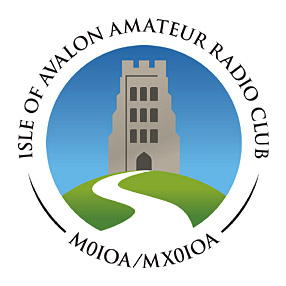Rig Expert AA-650 Zoom review
The AA-650 Zoom is a new product from the renowned Ukrainian company Rig Expert, and was obtained from Martin Lynch & Sons for £572 delivered. This is a brief and preliminary review summarising the unit’s specification and performance.
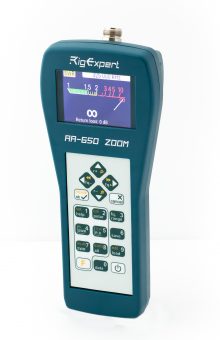
This instrument is a comprehensive antenna analyzer and RF utilities meter covering (and programmed with) all amateur bands from 136kHz (2.2km) to 435MHz (70cm). It has a number of interesting features including a facility for remote SWR adjustment called SWR2Air.
The package contains the analyzer (without the usual ‘demo’ batteries), a carry case with a strap and a transparent front through which the meter can be operated, two N connector adaptors (BNC, SO-239), a USB cable and a manual.
The analyzer is a large and strongly made hand held type in a distinctive blue colour. It has a waterproof membrane type keypad with clearly marked keys, a 320x240 display and an N type connector. In the hand the meter feels rugged. The battery hatch is like that of a power tool, and accepts three AA batteries, NiMH being acceptable.
The display has smaller resolution than those of some cheaper analyzers but is extremely well designed, bright, clear and legible.
On powering up one is told the serial number and firmware version, then presented with the main menu (Smith chart, SWR chart, R,X chart, SWR meter, All params, Setup, Calibrate, RL chart, TDR chart, MultiSWR, Tools).
The Smith chart function allows the characteristics of the test article (‘load’) to be displayed in this international standard form. Used largely by professional engineers and theoreticians, the Smith chart is less popular with British amateurs. However this function does allow one’s results to be published in the proper style familiar to one’s academic betters.
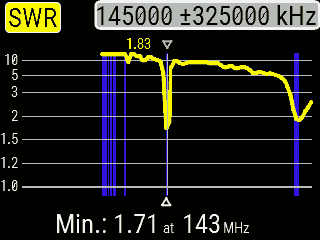
The SWR chart function produces the well-known frequency-domain plot with frequency across and SWR up (or down).
The meter’s Zoom specification means that it is possible to change the parameters of this display dynamically, with ‘up-and-down’ keys, rather than having to reprogram test ranges numerically.
R,X chart is used to measure the impedance (resistance and reactance) of the load. It would be used e.g. to determine the impedance of an antenna in order to design a matching network to connect the antenna to a specified feeder. To do this on the end of the feeder, it would be necessary to recalibrate the meter to eliminate the feeder’s contribution. This is provided for.
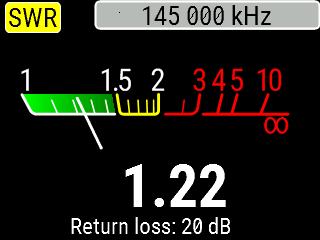
SWR meter displays a large clear SWR meter, updated slightly more than once a second, with both analogue and digital readouts. This function also allows the use of the SWR2Air feature (of which more later).
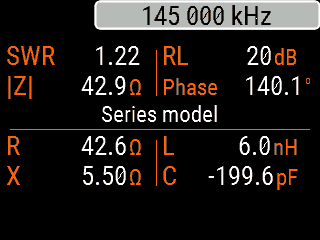
All params produces a concise numerical list of all of the load’s parameters.
Setup and Calibrate are administrative functions and do not test anything.
RL chart plots the return loss against frequency.
TDR chart provides a form of time-domain reflectometry (TDR), used to measure cable lengths or detect faults in transmission lines.
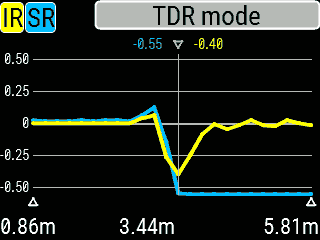
It does not work by the usual pulse generator and oscilloscope method, but by a mathematical process called IFFT.
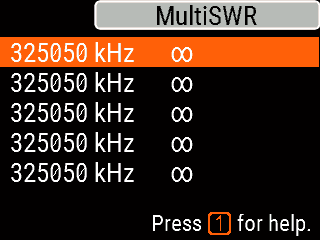
MultiSWR is intended for the adjustment of multi-band antennas. It is possible to measure SWR on five different bands at once, so that the effect of any change is immediately apparent.
While unlikely to interest the UHF enthusiast this function could make a great difference to HF people. It does not allow remote adjustment, however, as there is only one SWR2Air channel available.
Alas the reviewer does not have a multi-band antenna available to demonstrate this feature.
Tools include a stub tuner, cable length or velocity factor measurement (but not both at once, as experiment soon showed), cable loss, cable impedance and self tests.
The meter is supplied with a USB cable which allows it to be connected to a Windows PC or a Mac. One may download an application called AntScope2 which effectively remote-controls the meter and allows screenshots of its display to be saved, also providing many other extra facilities.
An unusual feature of this meter is the SWR2Air remote adjustment facility. This works by transmitting on (e.g.) 2m a simply coded signal which indicates the measured SWR. An operator with a handheld may then go and adjust the antenna, having left the meter at the shack end of the feeder measuring the SWR and transmitting its results to the handheld while this is done, eliminating the old two-handed shouting method for ever.
This is a new feature and is quite undocumented in the issued manual, though it is discussed online. It was found simply impossible to make it work at all.
However the difference between Messrs. Rig Expert and their competitors is the speed and efficiency with which their engineer dealt with this problem on receipt of an e-mail report.
He immediately provided a link to a YouTube video of someone doing the procedure for setting up SWR2Air, along with a text summary of the salient points.
Alas this didn’t work either. It certainly activated the feature, but transmissions were heard all over the band, except on the chosen SWR2Air frequency, and they bore no relation to anything being displayed or measured.
He then suggested that the firmware might be out of date, and provided instructions and links for updating it. After a few tries (not being a regular Windows user) this worked perfectly and version 1.5 firmware was installed.
Immediately the problem resolved itself, and a steady stream of pulses, the pulse repetition frequency being inversely proportional to the measured SWR, was received on an adjacent FT-65 handheld, on the chosen SWR2Air frequency and nowhere else. Job done.
It has not been possible in this very brief review to explore this important product in all of its detail, nor to establish its absolute accuracy; however it seems safe to conclude that within its frequency limits (other models are available) it provides the majority of measurements required by the amateur experimenting with antennas and their feedlines, to an acceptable standard.
However when buying a car one may be told to look not so much at the car as at the fellow who’s trying to sell it to you. Though this is an expensive piece of test gear it is built to last and the company who make it have demonstrated that they have a quite unfashionably pre-21st century view of customer service.
It is possible to buy a Chinese 700MHz antenna analyzer with a screen larger than this meter has for rather less money but as always one gets what one pays for; this is an unusually well-designed and strongly made instrument, and its excellent user interface and the high standard of customer service and support provided by its manufacturer are likely to be seen as much more than enough to offset only about £140 of cost difference.
Why should one buy such a thing at all, when it costs as much as a nice rig? Because it confers wizardly powers. It is a magic antenna wand which when connected to any conductive object will tell the wizard whether that object will ever be an antenna, and, if so, for what, or, if not, why not. It will over time save much money by allowing decent aerials and their accessories to be made out of scrap, and might one day even save the life of a rig worth much more than itself. Strongly recommended. And thanks to Alex Antonov and his colleagues in Kiev for an instructive afternoon.
AA 650 Zoom review by G6UVO
